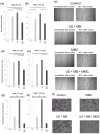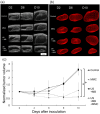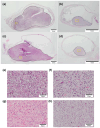Ultrasound irradiation in the presence of microbubbles may enhance the antitumor effect of chemotherapeutic agents against bladder cancer
- PMID: 39744489
- PMCID: PMC11685697
- DOI: 10.7150/jca.100846
Ultrasound irradiation in the presence of microbubbles may enhance the antitumor effect of chemotherapeutic agents against bladder cancer
Abstract
Intravesical instillation of chemotherapy has been performed to reduce the risk of intravesical recurrence of bladder cancer. However, its antitumor effect is not necessarily sufficient, which may be partially due to inadequate delivery of intravesically administered chemotherapeutic agents to bladder tumors. Ultrasound irradiation to target tissues in the presence of microbubbles is a technique to transiently enhance cell membrane permeability and achieve efficient drug delivery to the desired sites without damage to non-target areas; this technique has been used in chemotherapy, immunotherapy, gene therapy, and radiotherapy for the treatment of various cancers. However, the effectiveness of combining intravesical instillation of chemotherapy and this strategy for the treatment of bladder cancer has not been fully investigated. This report shows that mitomycin C combined with ultrasound and microbubbles has a higher antitumor effect than mitomycin C alone against mouse bladder cancer cells. Next, the antitumor effect of intravesical instillation of chemotherapy combined with ultrasound and microbubbles was demonstrated using an orthotopic mouse bladder cancer model. In vivo experiments showed that ultrasound irradiation in the presence of microbubbles enhanced the local delivery of fluorescent molecules and had the potential to enhance the antitumor effect of intravesical instillation of chemotherapy without visible damage to the surrounding normal tissues. The results of the present study demonstrate that intravesical chemotherapy combined with ultrasound and microbubbles is potentially a safe and effective treatment for bladder cancer.
Keywords: bladder cancer; drug delivery; intravesical instillation of chemotherapy; sonoporation.
© The author(s).
Conflict of interest statement
Competing Interests: The authors have declared that no competing interest exists.
Figures





Similar articles
-
Drug delivery system based on dendritic nanoparticles for enhancement of intravesical instillation.Int J Nanomedicine. 2017 Oct 10;12:7365-7374. doi: 10.2147/IJN.S140111. eCollection 2017. Int J Nanomedicine. 2017. PMID: 29066888 Free PMC article.
-
Long-Term Retention Microbubbles with Three-Layer Structure for Floating Intravesical Instillation Delivery.Small. 2023 Apr;19(14):e2205630. doi: 10.1002/smll.202205630. Epub 2023 Jan 12. Small. 2023. PMID: 36634975
-
Safety Assessment of Ultrasound-Assisted Intravesical Chemotherapy in Normal Dogs: A Pilot Study.Front Pharmacol. 2022 Mar 18;13:837754. doi: 10.3389/fphar.2022.837754. eCollection 2022. Front Pharmacol. 2022. PMID: 35370726 Free PMC article.
-
Diagnosis and management of superficial bladder cancer.Curr Probl Cancer. 2001 Jul-Aug;25(4):219-78. doi: 10.1067/mcn.2001.117539. Curr Probl Cancer. 2001. PMID: 11514784 Review.
-
[Intravesical chemotherapy of superficial bladder tumors].Gan To Kagaku Ryoho. 1989 Feb;16(2):193-8. Gan To Kagaku Ryoho. 1989. PMID: 2645832 Review. Japanese.
References
-
- Clark PE, Agarwal N, Biagioli MC. et al. Bladder cancer. J Natl Compr Canc Netw. 2013;11:446–75. - PubMed
-
- van Rhijn BW, Burger M, Lotan Y. et al. Recurrence and progression of disease in non-muscle-invasive bladder cancer: from epidemiology to treatment strategy. Eur Urol. 2009;56:430–42. - PubMed
-
- Lenis AT, Lec PM, Chamie K. et al. Bladder cancer: a review. JAMA. 2020;324:1980–91. - PubMed
LinkOut - more resources
Full Text Sources
Research Materials

